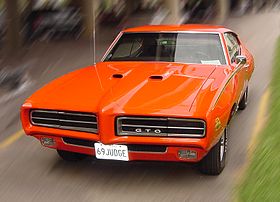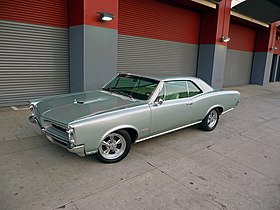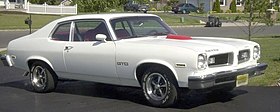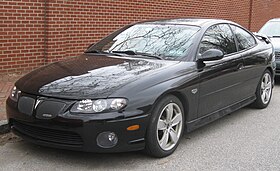Pontiac GTO
| Pontiac GTO | |
|---|---|

1969 Pontiac GTO the "Judge"
|
|
| Overview | |
| Manufacturer | |
| Production |
|
| Body and chassis | |
| Class | Muscle car |
| Layout | FR layout |
| Chronology | |
| Predecessor |
|
| Successor | None |
| First generation | |
|---|---|
 |
|
| Overview | |
| Production | 1964–1967 |
| Assembly | |
| Body and chassis | |
| Body style |
|
| Platform | A-body |
| Related | |
| Powertrain | |
| Engine |
|
| Transmission | |
| Dimensions | |
| Wheelbase | 115.0 in (2,921 mm) |
| Length | 206.4 in (5,243 mm) |
| Width | 74.4 in (1,890 mm) |
| Second generation | |
|---|---|
 |
|
| Overview | |
| Production | 1968–1973 |
| Assembly | |
| Body and chassis | |
| Body style | 2-door convertible 2-door hardtop 2-door coupé |
| Platform | A-body |
| Related | |
| Powertrain | |
| Engine |
|
| Transmission | |
| Dimensions | |
| Wheelbase | 112.0 in (2,845 mm) |
| Length |
|
| Third generation | |
|---|---|
 |
|
| Overview | |
| Production | 1974 |
| Assembly | |
| Body and chassis | |
| Body style | |
| Platform | X-body |
| Related | |
| Powertrain | |
| Engine | 350 cu in (5.7 L) V8 |
| Transmission | |
| Dimensions | |
| Wheelbase | 111.0 in (2,819 mm) |
| Fourth generation | |
|---|---|
 |
|
| Overview | |
| Also called |
|
| Production | 2004–2006 |
| Assembly | Elizabeth, South Australia, Australia |
| Designer | GM Holden |
| Body and chassis | |
| Body style | 2-door coupé |
| Platform | V-body |
| Related | |
| Powertrain | |
| Engine | |
| Transmission | |
| Dimensions | |
| Wheelbase | 109.8 in (2,789 mm) |
| Length | 189.8 in (4,821 mm) |
| Width | 72.5 in (1,842 mm) |
| Height | 54.9 in (1,394 mm) |
| Curb weight | 3,725 lb (1,690 kg) |
The Pontiac GTO is an automobile that was built by Pontiac in generations from 1964 to 1974 model years, and by GM's subsidiary Holden in Australia from 2004 to 2006.
The first generation GTO was a muscle car of the 1960s and 1970s era. Although there were earlier muscle cars, the Pontiac GTO is considered by some to have started the trend with all four domestic automakers offering a variety of competing models.
For the 1964 and 1965 model years, the GTO was an optional package on the intermediate-sized Pontiac Tempest. The GTO became its own model from 1966 to 1971. It became an option package again for the 1972 and 1973 intermediate Le Mans. For 1974, the GTO option package was offered on the compact-sized Ventura.
The GTO was selected Motor Trend Car of the Year in 1968.
The GTO model was revived from 2004 to 2006 model years as a captive import for Pontiac, a left-hand drive version of the Holden Monaro, itself a coupé variant of the Holden Commodore.
In early 1963, General Motors' management banned divisions from involvement in auto racing. This followed the 1957 voluntary ban on automobile racing that was instituted by the Automobile Manufacturers Association. By the early 1960s, Pontiac's advertising and marketing approach was heavily based on performance. With GM's ban on factory-sponsored racing, Pontiac's managers began to emphasize street performance.
In his autobiography Glory Days, Pontiac chief marketing manager Jim Wangers, who worked for the division's contract advertising and public relations agency, states that John DeLorean, Bill Collins and Russ Gee were responsible for the GTO's creation. It involved transforming the upcoming second-generation Pontiac Tempest (which reverted to a conventional front-engine with front transmission configuration) into a "Super Tempest" with a larger 389 cu in (6.4 L) Pontiac V8 engine from the full-sized Pontiac Catalina and Bonneville in place of the standard 326 cu in (5.3 L) V8. By promoting the big-engine Tempest as a special high-performance model, they could appeal to the speed-minded youth market (which had also been recognized by Ford Motor Company's Lee Iacocca, who was at that time preparing the sporty Ford Mustang variant of the second generation Ford Falcon compact).
...
Wikipedia
